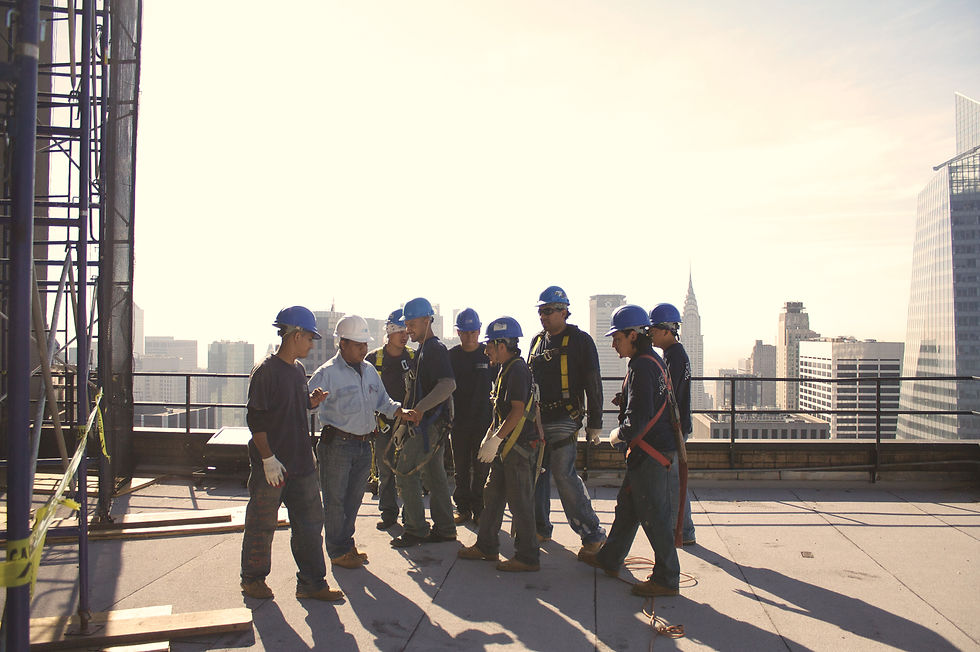Safety: The Crucial Role of Communication
- Eva Hatzaki, Editor
- May 2, 2016
- 4 min read

"We won't tolerate contractors who cut corners and recklessly increase the risks of construction work. We're quadrupling the penalties for the most frequent safety lapses, sweeping contractors with poor safety records at projects of less than 10 stories - where nearly three quarters of accidents occurred last year - and increasing oversight at these sites,” said Department of Buildings Commissioner Rick Chandler at a press conference on February 12, 2016. The construction industry is inherently dangerous, and construction sites, by their dynamic nature, pose safety risks to both workers and the public. This should be why safety is at the top of the list of concerns for construction companies. Maintaining a safe work environment is an essential part of what makes a company a desirable place to work and a prerequisite for selecting a trusted project partner. The commitment to building a safe work environment begins with the creation of regulations, safety protocols and best practices and continues with the adherence to these rules on the jobsite. Once this is established, the responsibility shifts from City agencies to employers and employees and the level of safety awareness that has to be reinforced on a daily basis. Safety must be ingrained in the company’s mission and culture, as the cornerstone of its commitment to the well-being of all. In order for a company to make safety the number one priority, it must be a mantra repeated daily by everybody from senior executives to the newest member of the team. By constantly reminding everyone of the potential harm workers face each day on the job, building a safe environment becomes a common goal where everyone is a part of the solution. This thoughtful process builds a strong cohesion among employees where everyone is responsible for each-others’ safety, rather than just being the responsibility of key individuals such as site-safety managers, project managers, superintendents, and foremen. Although these individuals are held to maintaining a standard in the field and performing what is in their job description, it is the duty of all employees to talk about safety every day and to also speak up when rules are broken or an individual’s lax safety attitude threatens the well-being of themselves or others around them.
Leading the charge and setting an example for others is an objective that all workers must reach because accidents continue to rise in the construction industry. According to the NYC Department of Buildings (DOB), 433 accidents and 11 deaths were recorded in 2015, which was an increase from the 231 accidents and 8 deaths reported in 2014. A nationwide statistic shows a fatality rate of 9.5 per 100,000 workers, with the private construction industry claiming 899 lives in 2014. Most accidents are concentrated around four areas that the Occupational Safety and Health Administration (OSHA) deemed the “fatal four”, which are responsible for more than half of the construction related incidents.
These are:
• Falls • Electrocution • Struck by Object • Caught in-between
By raising awareness around the aforementioned statistics and risks within the industry, a company can greatly reduce the chances of accidents occurring by keeping a constant level of alertness in its work force at all times. Although many laws and regulations are created to keep accidents from occurring, oftentimes injuries in the field are unavoidable. Fortunately, many accidents can be avoided, and it is the job of employers to target those factors that can mitigate risk and ensure these are fully implemented at every jobsite. Many of these are mandatory requirements that can be sometimes overlooked such as:
• Employee training
• Proper jobsite inspection
• Adhering to OSHA jobsite safety standards
• Following DOB rules and regulations
• Monitoring health-related warning signs
• Monitoring extreme weather conditions
OSHA and the DOB work tirelessly to make sure that employers and employees are kept safe in the workplace. Efforts to improve jobsite safety have been continuous, ranging from new city laws [the DOB has issued 25 new laws since 2008] to higher penalties for safety violations [OSHA penalties for safety violations are set to increase by 80% on August 1, 2016]. Additionally, the DOB is hiring 100 additional site safety inspectors to continue to fight against the rising incident rate. Just as OSHA and DOB work for employers and the public, contractors must return the favor by abiding by these rules and regulations, while undertaking additional measures to compliment and heighten the effect of those already in place. These additional efforts include:
• Daily safety or “toolbox” meetings
• Continuous training on tools and equipment
• Participation in safety seminars and events
Ultimately, the goal is to create a communication system that is proactive, rather than reactive. Being safe is a driver of growth and productivity, and without communication, safety is compromised. By raising awareness and taking these steps, companies and their workers can come together to stay informed and alert.
Safety should be a personal goal for every member of an organization, where a sense of esprit de corps and shared responsibility can enhance the working experience and encourage each other to stand up for safety in the construction industry.

Safety protocol calls for a Competent Person onsite who is responsible for making sure all workers follow safety measures, such as properly using harnesses, tools and equipment, in addition to wearing PPE (Personal Protective equipment) such as hardhats, work boots and safety glasses, while at the job site.




Comments